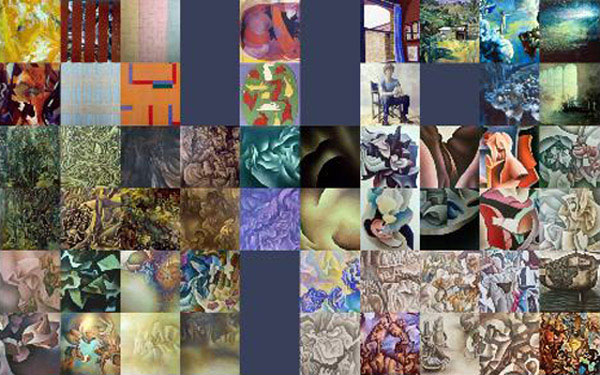

Paintings
The image above shows two paintings for each of thirty years from 1976 to 2006. There are a few gaps, for years when I didn’t produce two paintings.
I first wrote this story in 2006 after giving a talk on my work at Warrnambool TAFE. There have been some changes in my work since 2006, but this is gradually being reflected in this story. See below!
My father was a doctor from Scotland. His father was a botanist who spent many years studying plants in India. My father met my mother in Australia during the Second World War. She followed him back to Scotland, and then, fleeing his own mother, they moved to England. This picture is of Edinburgh University boxing team 1937-38. My dad is in the back row, second from the left.
I grew up fascinated by natural history, particularly the world of insects. My grandmother gave me her collections of butterflies and moths from her time spent in India. They smelt of camphor. I started my own insect collections.
When I finished school, I decided to study medicine. It wasn't a very good decision. I hated it. Now, I look back on days of studying anatomy, dissecting bodies and so on, as quite intriguing. But at the time, it was awful.
These illustrations were done by an anatomist called Jamieson at Edinburgh University. He taught my father. When my father was studying anatomy, Jamieson used to bring the drawings into the class - they were done in chalk on blackboards. These illustrations were the first ones that he published in colour, in about 1932.
I don't think I really appreciated the subtleties of anatomy when I was at medical school. It’s an extraordinary area of study, requiring an understanding of the exact relations of all the different organs, muscles and so on.
There is a particular sort of spatial geography going on here - mapping in all three dimensions. You can see how contemporary 3D designers might have a ball with this, but I think these old anatomy drawings are special, because they achieve the same result without leaving the page, without movement and with a minimum of fuss.
My background in science leads to a particular way of looking at the structure of things. This is related to the way that people in early modern times tried to classify everything. There was a strong desire in the 17th and 18th centuries to order and control the world and especially nature. The tools for doing it were rational thought and analysis. Even dreams and the subconscious, things that seemed beyond reason, were analysed (Freud). I came out of a humanist, scientific tradition but there was something wrong with it all, for me. It is still hard for me to understand quite why that was so. But I found that art allowed me to explore the world in a way that seemed more natural.
I started my art career at St Martins in London in 1975. At that time, the dominant mode at St Martins was abstract expressionism, after the model of the 1950s New York school, even though it was already twenty years on. But I had a lot of ground to catch up, because I hadn't done much in the way of preparatory schooling in all the many other modes of painting. So I was all over the place at the beginning.
This is a painting from that era by Gillian Ayres, who was the head of the first year in the painting department at St Martins. You may see how it reflects New York school values, particularly the idea of truth to materials. It goes one step beyond 'the medium is the message' to 'Paint itself is the message'. We used up a lot of paint.
Next chapter: Expressionism to systems